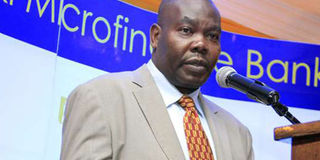Why there are many lenders but few takers

Rafiki Microfinance Bank Managing Director Ken Obimbo announces the 2nd edition of the East Africa Chama Awards on February 24, 2016. Experts are now poking holes on this rosy picture of Kenya’s access to financial services. PHOTO | DIANA NGILA | NATION MEDIA GROUP
What you need to know:
- The 2016 FinAccess Household Survey says the ratio of Kenyans with access to credit has risen dramatically in the past decade from 26.7 per cent in 2006 to 75.3 per cent in 2016.
- Expansion of financial services in Kenya started mainly in 2007 when global telcoms giant Vodafone included the country in its mobile money pilot project, spawning M-Pesa.
Most Kenyans with access to credit shirk away due to prohibitive charges imposed by lenders.
University of Nairobi economics lecturer Michael Chege says many Kenyans can secure loans from many sources but they are technically barred by prohibitive charges.
“There is a gap between access and financial inclusion,” he says.
Some experts have likened this to a poor population that has access to luxury products but lacks the money to buy them.
The 2016 FinAccess Household Survey says the ratio of Kenyans with access to credit has risen dramatically in the past decade from 26.7 per cent in 2006 to 75.3 per cent in 2016.
A similarly picture is painted by the 2015 Brookings Financial and Digital Inclusion Project Report which ranked Kenya first, with 89 per cent, followed by South Africa (80 per cent), Brazil (78 per cent), Rwanda/Uganda (75 per cent each), and Chile, Colombia and Turkey (74 per cent each).
The rankings were based on overall access to financial services against 33 indicators spanning four “dimensions” — namely, country commitment, mobile capacity, regulatory environment, and adoption.
Expansion of financial services in Kenya started mainly in 2007 when global telcoms giant Vodafone included the country in its mobile money pilot project, spawning M-Pesa.
The market dominance of Vodafone’s subsidiary, Safaricom, gave M-Pesa a massive reach in the country.
From just 17,000 subscribers in 2000, Safaricom had 7.4 million customers in 2007, comprising 70 per cent of the market as at August that year.
Regulators led by former Central Bank of Kenya Governor Njuguna Ndun’gu took a gentle stance towards innovation, with the telcoms regulator initially undecided on how to respond. This allowed M-Pesa to thrive.
Central Bank was at the same time advocating banking reforms to improve service access, such as agency banking and licensing of deposit-taking microfinances.
But experts are now poking holes on this rosy picture of Kenya’s access to financial services. They say “inclusion” should not be an end in itself, but a means.
The volume of cash moved through mobile platforms grew by a fifth last year to hit a new record.
ACCESS TO FINANCE
Central Bank data shows that mobile money payments grew to Sh2.8 trillion as at December 2015, compared with Sh2.3 trillion a year earlier.
This was a 19 per cent jump. Even then, financial providers have been accused of failing to deliver on the needs of users on relevance, affordability and benefit-sharing.
Undeniably, Kenyans have been enabled to do transfers most effectively. What may be pending is viable savings and borrowing, said a senior executive of a local financial institution.
Many people have singled out the high cost. With mobile lending fees at between 7 per cent and 10 per cent a month (an annual percentage rate of about 84 per cent to 120 per cent) and between 24 per cent and 36 per cent, few take up loans.
Meanwhile, mobile firms have been accused of failing to pass on the huge savings made by mobile lending, compared with the expensive brick and mortar branches.
But co-operative societies, notably saccos with front-office banking are cited as providing true financial access.
Their members have been doubling, with many enjoying benefits like affordable credit and dividend pay-outs.
The exception is the co-operative model, which is guaranteeing many people access to finance at reasonable rates.





